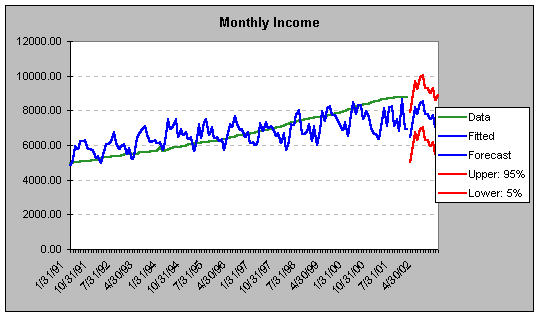
Time Series Forecasting Project: Auto Sales and U.S. Monthly personal Income
Objective
Time-series models use a technique to extrapolate the historical behavior into the future. Figuratively, the series are being lifted into the future "by its own bootstraps." Time series data are historical in chronological order, with only one value per time period. This project aim s to use CB predictor to determine the best time series model used for predicting future value.
Variable and Measurements
CB predictor used eight different time-series modeling methods to obtain the best fit to the historical data series. CB predictor selects the best model based on the lowest Root Mean Square Error (RMSE) which resulted in the selection of the Holt-Winters Multiplicative model.
Mathematical Model
As mentioned earlier, CB predictor chose the best model of forecasting which is Holt- Winters Multiplicative.
Method ranking Table
Method RMSE MAD MAPE Best: Holt-Winters' Multiplicative 63.8 47.386 3.61% 2nd: Seasonal Multiplicative 66.237 50.329 3.83% 3rd: Holt-Winters' Additive 69.381 52.092 4.09% 4th: Seasonal Additive 70.657 53.532 4.19% 5th: Double Moving Average 134.14 109.39 8.18% 6th: Single Exponential Smoothing 136.1 109.38 8.43% 7th: Single Moving Average 136.62 110.76 8.31% 8th: Double Exponential Smoothing 137.59 111.41 8.68%
RMSE (root mean square error) is an absolute error measure that square the deviations to keep the positive and negative deviations from canceling each other out.
MAD (Mean Absolute deviation): This an error that averages distance between each pair of actual and fitted data point.
MAPE (Mean absolute percentage error): this is a relative error measure that uses absolute values to keep the positive and negative errors from canceling each other out and uses relative errors to let you compare forecast accuracy between time-series model.
Method Statistics: Method Durbin-Watson Theil's U Best: Holt-Winters' Multiplicative 2.019 0.429 2nd: Seasonal Multiplicative 2.001 0.449 3rd: Holt-Winters' Additive 1.993 0.458 4th: Seasonal Additive 2.011 0.468 5th: Double Moving Average 1.516 0.867 6th: Single Exponential Smoothing 2.014 0.943 7th: Single Moving Average 1.295 0.9 8th: Double Exponential Smoothing 2.025 0.942 Method Parameters: Method Parameter Value Best: Holt-Winters' Multiplicative Alpha 0.228 Beta 0.001 Gamma 0.001 2nd: Seasonal Multiplicative Alpha 0.287 Gamma 0.001 3rd: Holt-Winters' Additive Alpha 0.291 Beta 0.001 Gamma 0.001 4th: Seasonal Additive Alpha 0.335 Gamma 0.001 5th: Double Moving Average Periods 14 6th: Single Exponential Smoothing Alpha 0.609 7th: Single Moving Average Periods 14 8th: Double Exponential Smoothing Alpha 0.627 Beta 0.014
The following graph shows a well fit between the projected data and the historical data.

Model Validity and Testing
Date Lower5% Forecast Upper 95%
1/31/02 1117.20 1222.95 1328.70 2/28/02 1278.44 1385.01 1491.57 3/31/02 1540.69 1648.08 1755.48 4/30/02 1435.56 1543.79 1652.02 5/31/02 1587.04 1696.13 1805.21 6/30/02 1610.97 1720.92 1830.87 7/31/02 1429.86 1540.69 1651.52 8/31/02 1430.43 1542.15 1653.88 9/30/02 1360.88 1473.51 1586.14 10/31/02 1414.92 1528.47 11/30/02 1249.87 1364.36 12/31/02 1317.43 1432.88
Spreadsheet model